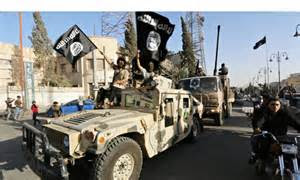 |
| ISIS On The Move With US Equipment |
A key weapon deployed by ISIS is fear, with gruesome propaganda video being released by ISIS, it is no wonder the Iraqi soldiers and police often strip off their uniforms and runaway. It's not only bad over there, it's getting worse. For us living in America if you don't look for the news flowing out of the Middle East you are most likely shielded from much of it. The Middle East is in total flux and many of the developments occurring on a daily basis are very problematic. News from the region tends to slip by under the radar because it is not something the public wants to see and not something Washington wants to put before us. It is a solid reminder that we must never underestimate mans ability to inflict damage upon the human-race and people just trying to go about living their lives. Time and time again across the world the brutal carnage continues and recent well documented acts of ISIS and so many other groups around the globe give us little hope that it will abate.
We should not be surprised if before long ISIS begins banging on the gates of Baghdad and creates a situation reminisce of the street to street fighting that took place in Beirut, Lebanon years ago. This would threaten the fortified U.S. Embassy located in the Green Zone. This is America's largest embassy in the world, the embassy compound can hold 35,000 American personnel and is basically a small city/state within Baghdad and is massively defended. The goal of ISIS fighters would most likely be to cause panic and destabilize the area which would result in a major PR victory. This means fire fights breaking out everywhere within the borders of Baghdad as forces backed by Shiite Iran facing off against Sunni rebels with ties and money from Saudi Arabia in a fight for control, but this gets very twisted in that even strong breaks exist between the Sunnis. We are talking about the city becoming ground zero and entering a state of civil war.
While military experts are confident that ISIS does not have enough troops to take Baghdad, a city of around eight million people. Baghdad has been a city in transition since the Bush invasion created a power vacuum. We have witnessed an endless violence in the capitol that is historically full of neighborhoods with a mix of Sunni and Shia. Today the population division is now almost complete with most Shia concentrated in the north and east of the river and most Sunni in the area stretching from the airport to the American Green Zone. The ISIS advance in Anbar province to just outside the airport is a direct threat to the Green Zone because their forces can move through predominantly Sunni neighborhoods with little resistance. The western Sunni neighborhoods are perfect cover for ISIS to slowly infiltrate the area around the Green Zone and embassy compound by mixing in with the population. It is possible to see where ISIS could shut down the airport or at least make air travel extremely dangerous.
A scenario that must be considered is we will see an attack against the heavily defended the U.S. embassy and the Green Zone. This would require the U.S. to fly in reinforcements to the airport and this will be when ISIS will start mortar fire and attempt to close the Baghdad airport as well as attack convoys through the Sunni neighborhoods heading to the Green Zone. Shutting down the airport would require reinforcements and embassy staff leaving to use helicopters for transportation to airfields further south in Iraq or maybe even to Kuwait. Closing the airport would constitute a major public relations victory for ISIS and make life very difficult for those who oppose them. It could get very ugly fast, if a siege of the Green Zone and American embassy occurs because the U.S. would most likely then attack by air the Sunni neighborhoods surrounding the area from the zone west to the airport at a minimum resulting in heavy Sunni civilian causalities.
Since inheriting the throne earlier this year Saudi King Salman has forcefully challenged the expanding regional influence of Iran his country's biggest foe. This is very apparent from the Saudi's embarking on an air war against Iranian-backed Houthi rebels in Yemen. He is coordinating with Qatar and Turkey and has moved to shore up the deeply divided rebels in Syria. This has brought together an unexpectedly cohesive and effective rebel coalition made up of al-Qaeda affiliate Jabhat al-Nusra, an assortment of mostly Islamist brigades and a small number of more moderate battalions. This has added growing strains on Assad’s manpower and resources and damaged the idea that he is winning and the argument that Assad is the best option against ISIS. Bottom-line is that the whole region is in flux and ISIS is exploiting the situation. While difficult to believe if we do not get a handle on the situation in the end we could see the U.S. forced to close the embassy and withdraw from the Green Zone in a way that reminds the American public of how we left Vietnam long ago.
Footnote; This article is a "notice and warning" and not a suggestion of any strategy or solution that would solve the problem. My thoughts on that subject will be put forth at another time. As always, thanks for reading and your comments are encouraged. More on how America is failing in its fight against ISIS in the article below.
http://brucewilds.blogspot.com/2015/06/isis-undeterred-by-weak-us-strategy.html








